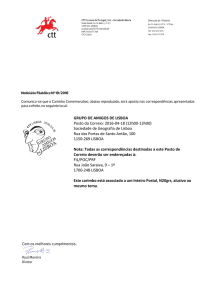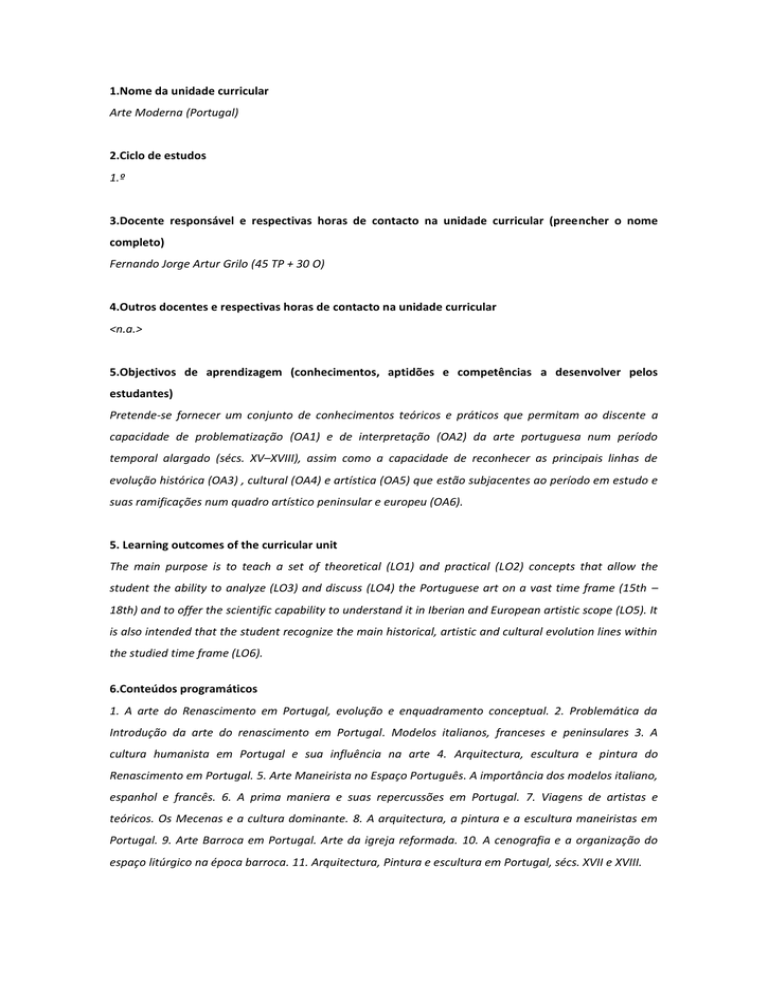
1.Nome da unidade curricular
Arte Moderna (Portugal)
2.Ciclo de estudos
1.º
3.Docente responsável e respectivas horas de contacto na unidade curricular (preencher o nome
completo)
Fernando Jorge Artur Grilo (45 TP + 30 O)
4.Outros docentes e respectivas horas de contacto na unidade curricular
<n.a.>
5.Objectivos de aprendizagem (conhecimentos, aptidões e competências a desenvolver pelos
estudantes)
Pretende-se fornecer um conjunto de conhecimentos teóricos e práticos que permitam ao discente a
capacidade de problematização (OA1) e de interpretação (OA2) da arte portuguesa num período
temporal alargado (sécs. XV–XVIII), assim como a capacidade de reconhecer as principais linhas de
evolução histórica (OA3) , cultural (OA4) e artística (OA5) que estão subjacentes ao período em estudo e
suas ramificações num quadro artístico peninsular e europeu (OA6).
5. Learning outcomes of the curricular unit
The main purpose is to teach a set of theoretical (LO1) and practical (LO2) concepts that allow the
student the ability to analyze (LO3) and discuss (LO4) the Portuguese art on a vast time frame (15th –
18th) and to offer the scientific capability to understand it in Iberian and European artistic scope (LO5). It
is also intended that the student recognize the main historical, artistic and cultural evolution lines within
the studied time frame (LO6).
6.Conteúdos programáticos
1. A arte do Renascimento em Portugal, evolução e enquadramento conceptual. 2. Problemática da
Introdução da arte do renascimento em Portugal. Modelos italianos, franceses e peninsulares 3. A
cultura humanista em Portugal e sua influência na arte 4. Arquitectura, escultura e pintura do
Renascimento em Portugal. 5. Arte Maneirista no Espaço Português. A importância dos modelos italiano,
espanhol e francês. 6. A prima maniera e suas repercussões em Portugal. 7. Viagens de artistas e
teóricos. Os Mecenas e a cultura dominante. 8. A arquitectura, a pintura e a escultura maneiristas em
Portugal. 9. Arte Barroca em Portugal. Arte da igreja reformada. 10. A cenografia e a organização do
espaço litúrgico na época barroca. 11. Arquitectura, Pintura e escultura em Portugal, sécs. XVII e XVIII.
6.Syllabus
1. Renaissance Art in Portugal. Conceptual evolution. 2. The problem of the introduction of Renaissance
Art in Portugal. Italian, French and peninsular models. 3. The humanist culture in Portugal and its
influence in Art. Patrons and the dominat culture. 4. Renaissance architecture, sculpture and painting in
Portugal. 5. Mannerist Art in the Portuguese space. The importance of the Italian, Spanish and French
models. 6. The prima maniera and its repercussions in Portugal. 7. Artists and theorists travels. 8. The
mannerist architecture, painting and sculpture in Portugal. 9. The Baroque art in Portugal. The art of the
reformed church. 10. The scenography and organization of the liturgical space in the Baroque.
11.Architecture, painting and sculpture in Portugal, in the 17th and 18th centuries.
7.Demonstração da coerência dos conteúdos programáticos com os objectivos de aprendizagem da
unidade curricular
O programa da UC está dividido em três grandes áreas temáticas e cronológicas: Arte do Renascimento,
Arte Maneirista e Arte Barroca e Rococó. Cada área compreende sempre a inclusão de vários objetivos
de aprendizagem (OA) de forma integrada entre os conhecimentos históricos e artísticos. Análise
sistemática de estudos de caso resultantes de publicações e investigação realizadas pelo docente de
modo a atingir os OA definidos.
7.Demonstration of the syllabus coherence with the curricular unit's objectives
The course syllabus is organized in three thematic and chronological areas: Renaissance Art, Maneirism
and Baroque and Rococó art. Each area of historical, cultural and artistic knowledge implies several
outcomes (LO) always in a holistic perspective. Systematic analysis of case studies resulting from the
publications and research carried by the teacher.
8.Metodologias de ensino (avaliação incluída)
Aulas expositivas com componente teórica e prática, com recurso sistemático a meios audiovisuais em
todos os tempos lectivos. Análise personalizada teórica e prática de obras de arte (arquitectura, pintura,
escultura e artes decorativas) dos períodos cronológicos em estudo, com especial incidência em
problemáticas e obras de arte já estudadas e publicadas ou em estudo pelo docente. Os métodos de
avaliação são a Avaliação contínua (AC) e a Avaliação final, dos discentes Os elementos de avaliação das
uc semestrais nunca poderão ser em n.º inferior a dois, um dos quais obrigatoriamente individual, escrito
e presencial. A AFA consistirá na realização de uma prova única, presencial.
8.Teaching methodologies (including evaluation)
Expositive classes with both a theoretical and practical components, using audiovisual mediums in every
lecture. Theoretical and practical analysis of works of art (architecture, painting, sculpture and
decorative arts) of the chronological periods in study, with special focus on problems and works of art
already studied and published or in study by the professor. The evaluation methods in FLUL are the
Continuous Evaluation (CA) and Final Evaluation alternative (AFA). The number, category and
percentage figure on the elements of evaluation to be made should be defined by the teacher. The
elements of evaluation of UC can be no less than two, one of them being individual written.
9.Demonstração da coerência das metodologias de ensino com os objectivos de aprendizagem da
unidade curricular
A articulação simbiótica entre as aulas teóricas / expositivas, privilegiando a leitura da obra de arte do
ponto de vista técnico, formal, estético e cultural, baseada em casos de estudos, a recomendação
sistemática de bibliografia especializada e a realização de visitas de estudo, gera a transmissão
suficiente de conhecimentos e de metodologias de análise do fenómeno artístico que permitem o
alcançar dos objetivos de aprendizagem definidos. As metodologias de ensino aplicadas nesta UC
permitem atingir os objectivos essências enunciados pois, não só permitem a criação de espaços de
transmissão de conhecimentos, entre docente e discente, como estimulam e permitem ao discente a
descoberta individual da Arte dos períodos em estudo. Pretende-se assim criar uma utensilagem
científica teórica e estimular a sua aplicação em contexto de visita de estudo ou em face da imagem
projectada na aula, incentivando sistematicamente a fundamentação e a confirmação à posteriori da
fruição inicial da obra de arte. A aprendizagem surge naturalmente da complementaridade entre o
discurso científico/teórico e o discurso visual, confirmado em visitas de estudo, contribuindo claramente
para que o discente compreenda a arte como uma linguagem formal, suas regras e seus âmbitos de
aplicação em contexto histórico e cultural.
9.Demonstration of the coherence between the teaching methodologies and the learning outcomes
The symbiotic relation between the theoretical classes and the expositive ones, prioritizing the work of
art’s reading from a technical, formal, aesthetic and cultural point of view, based in case studies, the
systematic recommendation of specialized bibliography and field trips, generated the sufficient
knowledge transmission and artistic phenomenon analysis methods that will allow the student to reach
the required goals.. The teaching methodologies applied in this UC helps to achieve the objectives
therefore not only allow the creation of spaces for knowledge transfer between teacher and students, as
stimulate and enable the individual discovery of the art of the periods under study. The aim is to create a
theoretical scientific methodology approach to stimulate the understanding of the artistic phenomenon
and its application in the context of Museum or monuments visitation or in view of the projected image
in class, systematically encouraging the foundation and the subsequent confirmation of the initial
enjoyment of the work of art. Learning comes naturally between scientific / theoretical discourse and the
visual speech, and also with the field trips, clearly helping the student understand art as a formal
language, their rules and their scope in historical and cultural context.
10.Bibliografia
Francisco de HOLANDA, Da Pintura Antiga, (1548), Lisboa, 1982; __, Diálogos em Roma, (1548), Lisboa,
1982;__, Do Tirar polo Natural, (1549), Lisboa, 1982;__, Da Fabrica que fallece à cidade de Lisboa,
(1571), Lisboa, 1984;__, De Quanto Serve a Ciencia do Desenho e Entendimento da Arte da Pintura na
Républica Cristâ, assim na paz como na guerra, (1571), Lisboa, 1982,; A.A.V.V., História da Arte em
Portugal, Lisboa, 1989, Alfa, 15 Vols; Vítor SERRÃO, O Renascimento e o Maneirismo, Presença, 2008,
Pedro DIAS, História da Arte Portuguesa no Mundo, III vols, 2010, Circulo de Leitores.

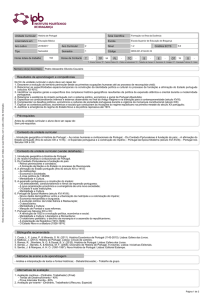
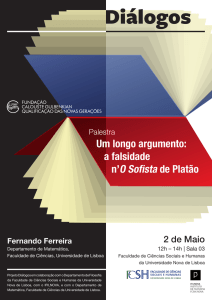
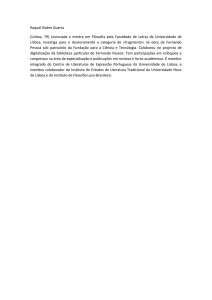
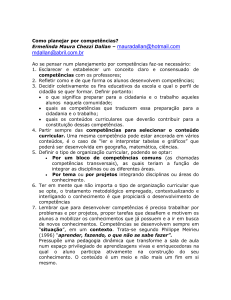
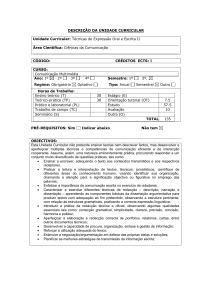
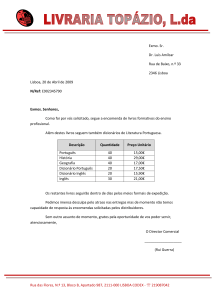
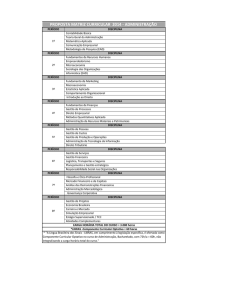


![Seminário [História Antiga]](http://s1.studylibpt.com/store/data/001254899_1-5f51363e7ff1a9132562b4d14bd1112c-300x300.png)
